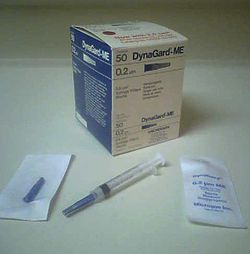- Syringe filter
-
A syringe filter (sometimes called wheel filter if it has a wheel-like shape) is a single-use filter cartridge. It is attached to the end of a syringe for use. Syringe filters may have Luer lock fittings, though not universally so. The use of a needle is optional; where desired it may be fitted to the end of the syringe filter.
A syringe filter generally consists of a plastic housing with a membrane which serves as a filter. The fluid to be purified may be cleaned by drawing it up the syringe through the filter, or by forcing the unfiltered fluid out, through the filter.
Contents
Forms
In scientific applications, the most common sizes available are 0.2 or 0.22 µm and 0.45 µm pores. These sizes are sufficient for HPLC use. The smallest known sterile syringe microfilter is Anotop 10 Syringe Filters Plus with pore size 0.02 µm. Membrane diameters of 10 mm, 13 mm, 25 mm are common as well. Some syringe filters for small volumes may be not resemble a wheel at all.
The syringe filter body may be made of such materials as polypropylene and nylon. The filter membrane may be of PTFE, nylon, or other treated products for specific purposes. Most manufacturers publish compatibility wallcharts advising users of compatibility between their products and organic solvents or corrosive liquids (e.g. trifluoroacetic acid).
Application
Syringe filters may be used to remove particles from a sample, prior to analysis by HPLC. Particles easily damage an HPLC due to the narrow bore and high pressures within. Syringe filters are quite suitable for Schlenk line work, which makes extensive use of needles and syringes. (See cannula transfer) Being relatively affordable, they may be used for general purpose filtration, especially of smaller volumes where losses by soaking up filter paper are significant.
Syringe filters are also available for the filtration of gases, and for the removal of bacteria from a sample.
Harm reduction in recreational drug use
See also: harm reductionSyringe filters may be used to filter solid drugs (powder and pill forms for eg.) prior to injection. Commonly filtered recreational drugs include heroin, methadone (Physeptone - See below), amphetamines, ecstasy or benzodiazepines. The filter still lets the drug through, but gets rid of many impurities such as fungal spores, bacteria or 'filler' used in the drug. Filters with 0.1 µm compared with 0.2 µm pore size have enhanced bacterial removal accrording to a study.[1] The use of wheel filters is strongly recommended when illicit drug users seek to inject prescription medications such as morphine and benzodiazepines that come in tablet form.
(Note: Physeptone is methadone in pill form, liquid methadone should never be injected; it is made for oral administration only, as it's supposed to be a step away from intravenous drug use. Complications can arise that include abcesses and clotting problems which can result in a major infraction.)
Pills like prescription opiates or benzodiazepines which are often converted by users into crude injectables, have ingredients such as chalk and wax as a 'filler', and illicit drugs are often adulterated with fillers to increase profits. Correctly used, wheel filters with at least pore size 0.5 µm[2] (e.g. Apothicom Sterifilt made for harm reduction) may reduce these impurities entering the blood stream and help avoid vein problems such as collapsed veins, abscesses, infections, embolism, 'dirty tastes', disease and septicemia.[citation needed]
While wheel filters are the most effective filter available for injecting drug users along with luer lock syringe tip filters, other more common types of filters used include cotton wool, tampons, and cigarette filters. While these can serve as basic filters, they have a greater risk of bacterial infection or contamination from pieces of the filter itself. The condition known as cotton fever is caused by cotton used as a filter.
See also
- Microfiltration
- Adulteration
- Drug injection
Notes
- ^ Sundaram, S; Auriemma, M; Howard Jr, G; Brandwein, H; Leo, F (1999). "Application of membrane filtration for removal of diminutive bioburden organisms in pharmaceutical products and processes". PDA journal of pharmaceutical science and technology / PDA 53 (4): 186–201. PMID 10754712.
- ^ http://www.saferinjecting.net/injecting-wheel-filters.htm
References
- Loxley, W., International Journal of Drug Policy,11 (6),Doing the possible: harm reduction, injecting drug use and blood borne viral infections in Australia pp. 407–416
External links
- Information on harm reduction strategies when using illicit drugs, from the Queensland Injectors Health Network
- Another guide for injecting drug users, from the New Zealand Needle Exchange Programme
Categories:
Wikimedia Foundation. 2010.

